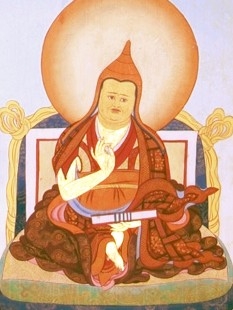Mipham Rinpoche Timeline: Difference between revisions
m (→1891 (45)) |
No edit summary |
||
| Line 1: | Line 1: | ||
[[Image:Mipham.JPG|frame|'''Mipham Rinpoche''']] | [[Image:Mipham.JPG|frame|'''Mipham Rinpoche''']] | ||
'''[[Mipham Rinpoche]] Timeline''' | '''[[Mipham Rinpoche]] Timeline''' | ||
==1846 (birth)== | |||
==1863 (Age 17)== | ==1863 (Age 17)== | ||
| Line 21: | Line 23: | ||
==1879 (33)== | ==1879 (33)== | ||
=== | ===[[Wangdü]]=== | ||
This was composed on the first day of the seventh month of the Earth Hare year (1879) by one named Dhih. | This was composed on the first day of the seventh month of the Earth Hare year (1879) by one named Dhih. | ||
Revision as of 09:25, 1 June 2009

Mipham Rinpoche Timeline
1846 (birth)
1863 (Age 17)
Pilgrimage to Central Tibet with uncle (according to Gene Smith).
1876 (Age 30)
Words to Delight My Teacher Manjughosha
Fire Mouse year (1876), commentary on Ornament of the Middle Way.
1877 (Age 31)
Warrior Song of Drala
Thus, on the twenty-fourth day of the third month of the Fire Ox year (1877), this was spontaneously composed by lamp light.
Söllo Chenmo (Gesar Practice)
This offering and invocation, as it arose in the mind of the White Rhinoceros Werma was first written down during the three years of the Fire Ox (1877), Earth Hare (1879) and Iron Dragon (1880) of the 15th calendrical cycle, and completed on the eighteenth of the month of Saga Dawa in the Iron Dragon year.
1878 (32)
Norbu Ketaka on Bodhicharyavatara, Chapter 9
August 9th according to Schuh.
1879 (33)
Wangdü
This was composed on the first day of the seventh month of the Earth Hare year (1879) by one named Dhih.
1880 (34)
Gesar practice 8th of the sixth month, Iron Dragon (1880)
1885 (39) Wood Bird
- Dön Nam Ngé Sherab Raldri
[Check Year!!] 29th of the 3rd month. Requested by Lobsang Gyaltsen.
1886 (40)
Jampal Dzogpachenpo
This was undertaken at the command of Jetsünma Dekyong Yeshe Wangmo, who is renowned as being an incarnation of the dakini Varahi, at the fortunate time of the fourth day in the third month [AP: of the Fire Dog year (1886)], accompanied by an auspicious scarf and the precious ornament of a crystal rosary.
1889 (43)
rGal lan nyin byed snang ba
A Reply to Criticism (of his commentary on the 9th Chapter of the Bodhicaryavatara) finished on June 11th according to Goodman.
1891 (45)
The Lion's Roar: A Commentary on Sugatagarbha
Treatise on buddha nature. Written in two days in Saga Dawa. The text was completed in 1891 after additional supplements were added to an earlier version.
Chegom Khorloma
This was written by Mipham Nampar Gyalwa in the Iron Hare year [1891] on the 18th day of the ripening month (Pleiades).
1894 (48)
Commentary on Madhyantavibhanga, written at Katok Dorje Den during the eighth and ninth months. He was there teaching Katok Situ.
1896 (50) Fire Monkey
Verses of the Eight Noble Auspicious Ones
1897 (51)
Prayer which is the Source of All True Realization (trulpé guru tsen gyé dang)
This arose from the lake of the mind of Jampal Dorje at dawn on the first day of the waxing moon of the month of Pleiades in the Fire Bird year (1897).
1901 (55)
Khenjuk
Requested by Sherab Ösel. Finished the ten topics (gnas bcu) in the winter of the Iron Ox (1901). Finished at Dzogchen Monastery in the Water Tiger (1902).
White Lotus
Completes The White Lotus, his famous explanation of the Seven Line Prayer, in the sixth month of the Iron Ox (1901) while staying at his hermitage in Dzogchen Shri Singha.
1903 (57)
Swift Fulfilment of All Wishes (lungta prayer)
These verses, which are of an auspicious number, were written in the Water Hare year (1903) on the auspicious occasion of the tenth day of the ninth month, in the hermitage of Padma Samten Deden Ling in Rudam, by Mipham Nampar Gyalwa. May virtue and goodness abound!
1904 (58)
(shing ‘brug)
sa bcad to the Khenjuk
Requested by Khenpo Sonam Chöphel Pal Zangpo and others, second month, written in hermitage (yang dben) in Rudam.
1906 (60)
Lamp to Dispel Darkness
This profound instruction was written by Mipham Jampal Dorje on the twelfth day of the second month, in the Fire Horse year (1906), for the benefit of village yogis and others, who, while not able to exert themselves too much in study and contemplation, still wish to take the very essence of mind into experience through practice. It has been set out in language that is easy to understand, in accordance with the experiential guidance of a great many old realized masters. Virtue! Mangalam!
1908
Kalachakra commentary.
1909
Commentary on Kavyadarsha.